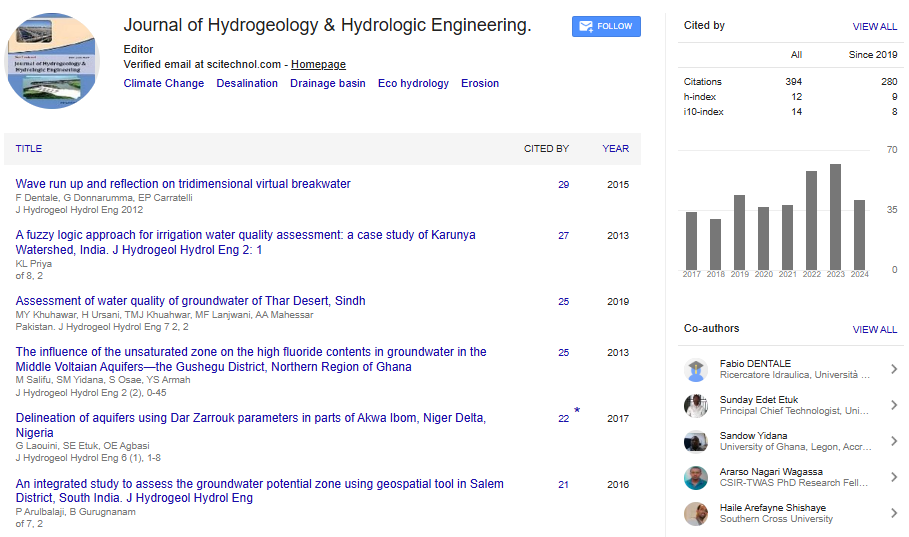Opinion Article, J Hydrogeol Hydrol Eng Vol: 13 Issue: 4
The Dynamic Relationship Between Weather Patterns and Water Systems in Hydrometeorology
Guoqing Wang*
1Department of Hydro Science and Engineering Research, Korea Institute of Civil Engineering and Building Technology, Gyeonggi-do, Republic of Korea
*Corresponding Author: Guoqing Wang,
Department of Hydro Science and
Engineering Research, Korea Institute of Civil Engineering and Building
Technology, Gyeonggi-do, Republic of Korea
E-mail: wangg298@gmail.com
Received date: 29 July, 2024, Manuscript No. JHHE-24-149251;
Editor assigned date: 31 July, 2024, PreQC No. JHHE-24-149251 (PQ);
Reviewed date: 14 August, 2024, QC No. JHHE-24-149251;
Revised date: 21 August, 2024, Manuscript No. JHHE-24-149251 (R);
Published date: 29 August, 2024, DOI: 10.4172/2325-9647.1000339
Citation: Wang G (2024) The Dynamic Relationship Between Weather Patterns and Water Systems in Hydrometeorology. J Hydrogeol Hydrol Eng 13:4.
Description
Hydrometeorology, an interdisciplinary science, focuses on the interaction between the atmosphere and Earth’s water systems. It lies at the intersection of meteorology and hydrology, examining how atmospheric phenomena such as precipitation, evaporation and atmospheric moisture transport influence terrestrial water systems. This field plays an essential role in managing water resources and predicting extreme weather events like floods and droughts.
One of the central aspects of hydrometeorology is its ability to track the movement of water through the atmosphere, primarily through precipitation and evapotranspiration. Rainfall is one of the primary variables in hydrometeorological studies, impacting rivers, lakes, reservoirs and soil moisture. Evapotranspiration, on the other hand, refers to the process by which water is transferred from land to the atmosphere via evaporation from soil and transpiration from plants. This cycle is precarious to maintaining the water balance in natural ecosystems and agricultural settings.
Accurate precipitation measurement is one of the key tasks of hydrometeorologists. They use various tools, including ground based rain gauges, radar systems and satellite observations, to estimate the amount of rain falling over specific areas. These measurements are used to assess potential risks, such as river flooding, by calculating how much water is likely to flow into rivers and reservoirs after a storm event. The integration of advanced technology, such as remote sensing, has significantly improved the capacity for real-time monitoring and forecasting in this field.
Flood forecasting, a major focus of hydrometeorology, is important for disaster preparedness. Flash floods and river floods can cause significant damage to infrastructure, human settlements and agriculture. Hydrometeorologists use predictive models based on historical data, real-time observations and climate forecasts to estimate the likelihood and intensity of flood events. For instance, models simulating the impact of a tropical storm on a river basin help in issuing timely warnings and explanatory damages. Furthermore, hydrometeorological models can assess the potential impact of snowmelt on river systems, which is particularly important in regions with heavy winter snowfall.
Drought prediction also falls within the domain of hydrometeorology. Droughts, defined by extended periods of low precipitation, affect water availability for agriculture, industry and human consumption. Hydrometeorologists study long-term weather patterns, soil moisture levels and evapotranspiration rates to forecast droughts. These forecasts are essential for implementing water conservation measures and planning for potential agricultural losses. Additionally, predicting drought conditions is increasingly important as climate change alters traditional weather patterns, making some regions more susceptible to prolonged dry spells.
One of the emerging concerns in hydrometeorology is the role of climate change. With rising global temperatures, shifts in atmospheric moisture patterns are causing more frequent and intense hydrological events, such as heavy rainfall, flooding and droughts. As a result, hydrometeorologists are working to develop more sophisticated models that account for these changes and help societies adapt to the evolving climate. They collaborate with climatologists, environmental scientists and engineers to address these challenges and ensure sustainable water management practices are in place.
Hydrometeorological research also extends to urban environments. Cities face unique challenges due to the dense concentration of infrastructure and people. Urban flooding, caused by heavy rainfall and inadequate drainage systems, can lead to widespread disruption. Hydrometeorologists study the effect of impervious surfaces, such as asphalt and concrete, on water flow and use their findings to inform city planners about effective drainage and stormwater management solutions.
In summary, hydrometeorology is a vital scientific field that informs water resource management, disaster extenuation and climate adaptation. Through advanced monitoring techniques and predictive models, hydrometeorologists provide insights that help alleviate the impacts of weather events on water systems, ensuring that both natural ecosystems and human populations remain resilient in the face of changing environmental conditions. The intersection of atmospheric and hydrological sciences continues to evolve, offering valuable tools to address some of the most pressing challenges related to water and weather.
 Spanish
Spanish  Chinese
Chinese  Russian
Russian  German
German  French
French  Japanese
Japanese  Portuguese
Portuguese  Hindi
Hindi 
